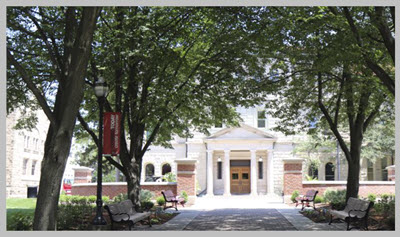
Ohio Wesleyan University
Ohio is filled with small colleges and universities founded around the middle of the 19th century by various religious groups. These range from nearly 65,000 students at Ohio State University to Kenyon College, a liberal arts school enrolling less than 2,000. Many of these small, private, liberal arts colleges still exist today, but with a non-denominational status.
 Ohio Wesleyan University can be found just outside of Columbus, Ohio, on a 200 acre campus with beautiful landscape. This school has a long history of community engagement and volunteering which is still active today, as 80 percent of the students are active in the surrounding community and school oriented services.
Ohio Wesleyan University can be found just outside of Columbus, Ohio, on a 200 acre campus with beautiful landscape. This school has a long history of community engagement and volunteering which is still active today, as 80 percent of the students are active in the surrounding community and school oriented services.
 Kenyon College is known as being an Ivy League school of the Midwest, and features an acceptance rate of only 34 percent. This school, the oldest liberal arts college in Ohio, has a rigorous English program and a rich literary tradition, evidenced by the outgrowth “Kenyon Review” magazine, strong drama department and an impressive list of graduates. A compelling head to head comparison between the two Ohio powerhouses, Kenyon and Wooster, can be found here.
Kenyon College is known as being an Ivy League school of the Midwest, and features an acceptance rate of only 34 percent. This school, the oldest liberal arts college in Ohio, has a rigorous English program and a rich literary tradition, evidenced by the outgrowth “Kenyon Review” magazine, strong drama department and an impressive list of graduates. A compelling head to head comparison between the two Ohio powerhouses, Kenyon and Wooster, can be found here.
 Denison University, located in Granville, Ohio, is a moderately selective liberal arts institution. Denison has its rigorous learning environment, centered on interdisciplinary integration.
Denison University, located in Granville, Ohio, is a moderately selective liberal arts institution. Denison has its rigorous learning environment, centered on interdisciplinary integration.
![]() Hiram College has a religious affiliation (Disciples of Christ), and is known for a code of conduct that students maintain, as well as a unique academic calendar: Two semesters, each divided into two sessions: one twelve week and one three week, from the basis of this radical academic program. During the three week session, students concentrate on one particular area of study.
Hiram College has a religious affiliation (Disciples of Christ), and is known for a code of conduct that students maintain, as well as a unique academic calendar: Two semesters, each divided into two sessions: one twelve week and one three week, from the basis of this radical academic program. During the three week session, students concentrate on one particular area of study.
 Oberlin College distinguishes itself from other Ohio schools, as well as from other schools nationwide. This is based in part on our annual “Liberal Arts Colleges Survey” that allows the student to rank his or her college in various categories, indicating that Oberlin students find abundant ways to challenge themselves while away at school.
Oberlin College distinguishes itself from other Ohio schools, as well as from other schools nationwide. This is based in part on our annual “Liberal Arts Colleges Survey” that allows the student to rank his or her college in various categories, indicating that Oberlin students find abundant ways to challenge themselves while away at school.
 Wittenberg University also still maintains its religious affiliation. Wittenberg distinguishes itself through more than just academic discipline. Similar to Hiram, there is a code of conduct for students to maintain. The Lutheran based school prides itself on educating the whole student, and works hard at instilling values that will last beyond the time spent there.
Wittenberg University also still maintains its religious affiliation. Wittenberg distinguishes itself through more than just academic discipline. Similar to Hiram, there is a code of conduct for students to maintain. The Lutheran based school prides itself on educating the whole student, and works hard at instilling values that will last beyond the time spent there.
The College of Wooster is another Ohio liberal arts college. For an in-depth comparison between Wooster and Kenyon, visit this page.
The Ohio liberal arts colleges mentioned here, still maintain the 19th century desire to leave the city and its’ distractions behind, and separate to a place where one can focus on academics and personal development. They represent the ideal goals of liberal arts colleges, emphasizing rigorous academics in a collaborative atmosphere.
